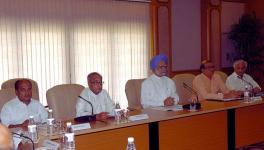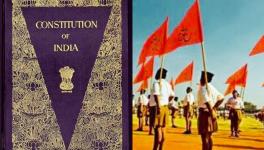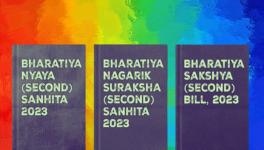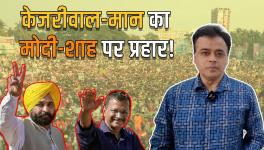Sarfaroshi Ki Tamanna Ab Hamaarey Dil Mei Hai
On this day, as students protest all over the country, in hundreds of colleges, towns and cities, remember Sarfaroshi ki Tamanna, the patriotic poem written in 1921 by Bismil Azimabadi and immortalised by the revolutionary anti-colonial freedom fighter Ram Prasad Bismil.
December 19 marks Shahadat Diwas, the day Bismil was hanged 92 years ago by the British rulers, when he was only 30, for his role in the planning and execution of the Kakori conspiracy along with Ashfaqulla Khan. Bismil, Khan and freedom fighters Roshan Singh were all hanged on the same day, and Rajendra Lahiri on 17 December, for participating in the same conspiracy.
Bismil had founded the Hindustan Republican Association and to fund its activities, including arms and ammunition, in 1925 they looted a train at Kakori near Lucknow in Uttar Pradesh. This train was said to be transferring India’s wealth to the British empire. In the loot, bags of money with roughly Rs.1,00,000 were carried away.
After his arrest, sentencing and martyrdom, Ashfaqulla became a legend, known across the country for his love for freedom, clear thinking and unshakeable courage and loyalty. For this reason, every Shahadat Diwas should be a moment for the nation to collectively reflect on those who sacrificed for India’s freedom. It is a moment to remember Bhagat Singh, Sukhdev and Rajguru, who were also hanged by the British imperialists four years later, on March 23.
Sarfaroshi ki Tamanna is a household anthem that inspired those who desired independence and still stirring those who value it. It poured into the popular consciousness, for it featured in a series of popular films: the 1965 Manoj Kumar-starrer Shaheed, which narrates the life of Bhagat Singh. It became the title song of the 1999 film, Sarfarosh..., the 2002 film The Legend of Bhagat Singh, the 2006 film Rang de Basanti, and the 2009 movie Gulaal directed by Anurag Kashyap.
Shahadat Diwas 2019, will go down in history as the day when lakhs of Indian youth, Left and democratic forces, civil society and many Opposition parties marched on the streets to protest the Black Law that repudiates the essence and spirit of India’s shared history of the freedom struggle, in which Hindus and Muslims fought side by side.
The Citizenship Amendment Act 2019 promises to confer citizenship to non-Muslim immigrants from Bangladesh, Pakistan and Afghanistan. It ignores persecuted minorities such as the Tamils, Madhesis, Ahmadiyyas, Rohingyas in India’s neighbourhood. It makes citizenship of India contingent on religious identity, thus violating the explicit prohibition against discrimination in Articles 14, 16 and 25 of the Indian Constitution.
The CAA is expected to be weaponised by the expected National Register of Citizens which the Home Minister Amit Shah has promised to execute right across the country. The NRC in Assam has sought documentary proof from everyone in the state for them or their ancestors to prove their residence in the region prior to 24 March 1971. The exercise ended up declaring 19 lakh people stateless. If executed across India, crores will be left stateless. The gauntlet of strict proof will fall heaviest on the shoulders of Indian Muslims, for the amended citizenship law says that India would bring in all but Muslims from abroad and declare them citizens without any documentary proof.
What does the state achieve by making people fearful of losing their citizenship, except that it undoes what the freedom fighters achieved? If the terror of becoming stateless now looms on every citizen. Does that not betray the legacy of India’s freedom struggle?
Indian Muslims are protesting in large numbers against the government’s communal citizenship scheme. But non-Muslims, despite repeated reassurances by the government, are also protesting. The Assamese do not want immigrants from Bangladesh to enter their state for the sake of preserving their rich culture—but the Assamese are also right here, protesting against the CAA.
The world media has widely reported that Pakistani Hindu groups have not just rejected but condemned India’s offer to migrate to India. Bangladesh foreign minister has mocked the CAA, calling attention to his country’s higher than 8% GDP growth rate, as against India’s 4% or so, coupled with unprecedented joblessness.
In the last 20 years, India has only received 33,000 applications for long-term visas from citizens of Pakistan, Bangladesh and Afghanistan, but there are 1 lakh or more Tamil Hindus of Sri Lankan descent waiting in refugee camps in India. Most immigrants from East Bengal (including my ancestors who came in 1950) have been Indian citizens for decades—then whom is the Indian government feigning to protect?
The hard-earned freedom and the Constitution India adopted to put a secular democratic republic in place are at stake today and that is what the Indian youth are on the ground to protect. The ridicule heaped on them by home minister Amit Shah that “22 universities” are protesting will certainly be belied on Shahid Diwas, 2019, as students of a hundred or more universities hit the ground, not to mention other citizens.
State governments and the Centre are responding by shutting access to the Internet in large parts of the country and blindly imposing section 144 of the Criminal Procedure Code across the capital and other parts of the nation shows how unnerved it is and how strong the movement against the CAA and NRC is.
Where does the movement go on from here?
First, this movement led by students needs to remain non-violent despite provocations by government agencies and ruling party goons. It must involve people from all backgrounds and focus on protecting the Constitution without drifting into sectarianism. Second, it must focus on the flailing economy, growing joblessness, rising prices, the sell-off of public assets such as BPCL, Indian Airlines, MTNL and BSNL, and on the closure of factories, especially the worst-hit small and medium sector, the failure of the government to generate revenues for public services despite amending the Goods and Services Tax code repeatedly, and so on. Three, it must demand democracy and preservation of the right to protest peacefully and against the brutal use of police force.
According to Statista, the infographic venture of Forbes, between 2016 and 2018 the Indian government stopped internet services 154 times, compared with 19 times in Pakistan and Syria and eight times in Iraq and Turkey. Certainly, the figures for 2019 will make India fall further in the rankings, for Kashmir has been denied access for over four months and now multiple cities are going without mobile internet services if there are any stirrings of an anti-CAA protest in them. So much for the world’s largest democracy.
People have a democratic right to protest peacefully. The Rs. 4.46 lakh crore “notional loss” that the public would foot in the sale of BPCL, as recently reported by The Hindu, is the loot of public property than a fire here or a bus damaged there during a protest that gets aggravated. Every so often, hired goons or the police itself (as suspected in Jamia Millia Islamia protests in Delhi, and apparently seen during the AMU protests, and also recorded in other protests, such as this one) are the reason for losses.
Most importantly, priorities need to be clearly stated and understood. India cannot feed a quarter of its 130-crore people adequately nutritious food. One-fifth of Indian citizens are illiterate, half the children, and almost half the women, are malnourished and one-third have no access to formal healthcare. Is it really India’s priority to settle, feed, educate, take care of healthcare needs of the people it seeks to import along religious lines from neighbouring countries? And, while welcoming illegal immigrants without documentation, can India throw its own people out for failing to produce decades-old papers despite their having Aadhaar cards, voter cards, etc?
Or is the real purpose of the government to identify, marginalise and turn the Indian Muslim into the ‘Other’, along with tribals and to keep the communal cauldron bubbling with this new project, now that the Ayodhya issue is ‘settled’?
A historic moment of judgment for the people of this civilisation is now, today, tomorrow and the day after. Sarfaroshi ki tamanna ab hamaarey dil mei hai/ Dekhna hai zor kitna baazu-e-kaatil mei hai.
The author is a columnist, academic and commentator on socio-political issues. The views are personal.
Get the latest reports & analysis with people's perspective on Protests, movements & deep analytical videos, discussions of the current affairs in your Telegram app. Subscribe to NewsClick's Telegram channel & get Real-Time updates on stories, as they get published on our website.























